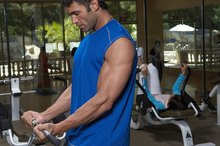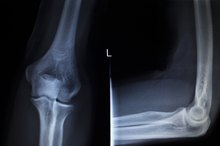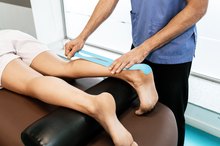While exercising, a number of injuries can occur, including a torn abdominal muscle 1. Sports-related injuries often happen when an individual is not completely stretched out prior to activity or puts too much strain on a particular muscle 1. Abdominal muscle tears can be quite painful, and require a period of rest to heal 1. There are also different symptoms of a torn abdominal muscle depending on the severity of the injury 1. To reduce the risks of torn muscles, be sure to stretch out completely before exercising and never put too much strain on the muscles.
If you are experiencing serious medical symptoms, seek emergency treatment immediately.
Anatomy of the Abdominal Muscles
Feel the muscles of the stomach. The abdomen wall is comprised of many muscles, some of which we don’t even know we flex until there is an injury. The rectus abdominis is the outermost muscle, which lays out in the front the stomach and is most visible when toned, appearing as a "six-pack." The external and internal oblique muscles run down the side of the abdomen wall. Usually individuals will train all of these muscles to have a tightened and toned midsection.
- Feel the muscles of the stomach.
- The rectus abdominis is the outermost muscle, which lays out in the front the stomach and is most visible when toned, appearing as a "six-pack."
Symptoms of Abdominal Muscle Tears
Signs & Symptoms of a Pulled Abdominal Muscle
Learn More
Identify the severity of a torn abdominal muscle 1. When an individual is injured in a sports-related activity, pain is often immediate. Lack of movement, cramping and muscle spasms and shooting pain are all associated with a torn abdominal muscle 1. In addition to these symptoms, there can also be apparent swelling and bruising shortly after the injury. Once an individual has a torn stomach muscle, it is hard to flex or stretch it out because it might appear at first to be a severe muscle cramp.
- Identify the severity of a torn abdominal muscle 1.
- Once an individual has a torn stomach muscle, it is hard to flex or stretch it out because it might appear at first to be a severe muscle cramp.
Grades of Abdominal Muscle Tears
Abdominal strains--or tears--are categorized into grades. There are three general grades, each of which describes the degree of tearing with the injury. Grade I is slight discomfort, to the point where an individual could carry on and continue an activity for a short time. The pain may not begin until after the activity has stopped. Grade II describes moderate discomfort, where the individual can no longer continue with activities that involve the abdomen and the abdomen is sore to touch. Finally, grade III is severe discomfort, where even the normal, day-to-day activities are virtually impossible to do until healing is complete. In grade III, the swelling or cramping usually accompanies the torn muscle pain. Grades II and III may also develop bruising; grade I does not.
- Abdominal strains--or tears--are categorized into grades.
- Finally, grade III is severe discomfort, where even the normal, day-to-day activities are virtually impossible to do until healing is complete.
Healing for a Torn Abdominal Muscle
Pulled Abdominal Muscle or a Hernia?
Learn More
Limit the amount of activity to efficiently heal. Because it is impossible to stop any movement of the abdomen muscles, reducing excess activity is necessary to heal. Time is the only way to heal a torn abdomen muscle and it is important to avoid exercise until the tear is healed. Icing the injury for the first 48 to 72 hours for 15 to 20 minutes every few hours will help to reduce swelling and the damage that can occur with that process.
- Limit the amount of activity to efficiently heal.
- Because it is impossible to stop any movement of the abdomen muscles, reducing excess activity is necessary to heal.
Prevention: Stretching and Overuse
Stretch before an activity. Before going to do any sport or physical activity, it is important to stretch the muscles in order to warm them up and be more flexible. Stretch thoroughly with side twists to warm up abdominal muscles and bend from side to side to warm up internal and external oblique muscles. Avoid adding excess strain to any muscle in order to prevent tears or even sprains 1.
- Stretch before an activity.
- Stretch thoroughly with side twists to warm up abdominal muscles and bend from side to side to warm up internal and external oblique muscles.
Related Articles
References
- American Academy of Orthopaedic Surgeons, OrthoInfo, "Diseases and Conditions: Muscle Contusion (Bruise)"
- Dines JS, Bedi A, Williams PN, Dodson CC, Ellenbecker TS, Altchek DW, Windler G, Dines DM. Tennis injuries: epidemiology, pathophysiology, and treatment. Journal of the American Academy of Orthopaedic Surgeons. 2015;23(3):181-9.









